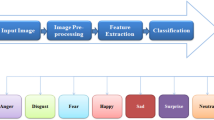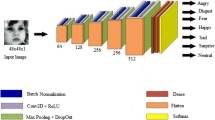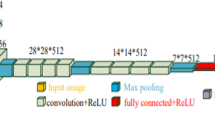Abstract
Aptitude, in terms of human facial recognition, cases prior one of digital image’s fundamental parts. This conveys facial parameters in many social contexts. Medical imaging, robotics, intrusion detection system with sentiment analysis, and automation and some industries use computer vision to understand human facial expressions. Studying human facial expressions using deep learning has become popular in recent years, and several efforts have been made. However, facial expression recognition remains challenging because of the wide range of persons with similar facial expressions. This paper proposed a 16-layer efficient CNN technique to categorize human facial expressions with data augmentation. Then, we evaluated our proposed approach on a well-known facial expression recognition, the FER2013 benchmark dataset. And, the proposed technique achieves state-of-the-art testing accuracy of 89.89\(\%\) exceeding some prior research.
Access this chapter
Tax calculation will be finalised at checkout
Purchases are for personal use only
Similar content being viewed by others
References
A. Mehrabian, Communication without words, in Communication Theory. (Routledge, UK, London, 2017), pp. 193–200
M. Shidujaman, H. Mi, Which country are you from? A cross-cultural study on greeting interaction design for social robots, in International Conference on Cross-Cultural Design. (Springer, Cham, 2018)
N. Christou, N. Kanojiya, Human facial expression recognition with convolution neural networks. in Third International Congress on Information and Communication Technology. (Springer, Singapore, 2019)
M. A. R. Refat, M. A. Amin, C. Kaushal, M. N. Yeasmin, M. K. Islam, A comparative analysis of early stage diabetes prediction using machine learning and deep learning approach, in 2021 6th International Conference on Signal Processing, Computing and Control (ISPCC) (2021), pp. 654–659
M.M. Hassan, M.A. Mamun Billah, M.M. Rahman, S. Zaman, M.M. Hasan Shakil, J.H. Angon, Early predictive analytics in healthcare for diabetes prediction using machine learning approach, in 2021 12th International Conference on Computing Communication and Networking Technologies (ICCCNT) (2021), pp. 1–5
C. Kaushal, M. A. R. Refat, M. A. Amin, M. K. Islam, Comparative micro blogging news analysis on the covid-19 pandemic scenario, ed. by M. Saraswat, S. Roy, C. Chowdhury, A. H. Gandomi, Proceedings of International Conference on Data Science and Applications. Lecture Notes in Networks and Systems, vol. 287 (Springer, Singapore, 2022)
N. I. Mahbub, M. R. Islam, M. A. Amin, M. K. Islam, B.C. Singh, M.I. H. Showrov, A. Sarkar, Sentiment analysis of microblogging dataset on coronavirus pandemic (2021 ). arXiv preprint arXiv:2111.09275
T. Zhang, Facial expression recognition based on deep learning: a survey. in International conference on intelligent and interactive systems and applications. (Springer, Cham, 2017)
J.B. Fugate, A.J. O’Hare, W.S. Emmanuel, Emotion words: facing change. J. Experimental Soc. Psychol. 79, 264–274 (2018)
N.T. Cao, A.H. Ton-That, H.I. Choi, An effective facial expression recognition approach for intelligent game systems. Int. J. Comput. Vis. Robot. 6, 223–234 (2016)
C. Clavel, I. Vasilescu, L. Devillers, G. Richard, T. Ehrette, Fear-type emotion recognition for future audio-based surveillance systems. Speech Commun. 50, 487–503 (2008)
Y. LeCun, L. Bottou, Y. Bengio, P. Haffner, Gradient-based learning applied to document recognition (1998)
T. Cao, M. Li, Facial expression recognition algorithm based on the combination of cnn and k-means, in ICMLC ’19 (2019)
P. Babajee, G. Suddul, S. Armoogum, R. Foogooa, Identifying human emotions from facial expressions with deep learning, in 2020 Zooming Innovation in Consumer Technologies Conference (ZINC) (2020), pp. 36–39
M. K. Islam, M. N. Yeasmin, C. Kaushal, M. A. Amin, M. R. Islam, M. I. Hossain Showrov, Comparative analysis of steering angle prediction for automated object using deep neural network, in 2021 9th International Conference on Reliability, Infocom Technologies and Optimization (Trends and Future Directions) (ICRITO) (2021), pp. 1–7
K. Liu, M. Zhang, Z. Pan, Facial expression recognition with cnn ensemble, 2016 International Conference on Cyberworlds (CW) (2016), pp. 163–166
A. Krizhevsky, I. Sutskever, G. E. Hinton, Imagenet classification with deep convolutional neural networks, ed. by F. Pereira, C. J. C. Burges, L. Bottou, K. Q. Weinberger. Advances in Neural Information Processing Systems, vol. 25 (Curran Associates, Inc., 2012), pp. 1097–1105
Y. Yadav, V. Kumar, V. Ranga, R.M. Rawat, Analysis of facial sentiments: a deep-learning way, in 2020 International Conference on Electronics and Sustainable Communication Systems (ICESC) (2020), pp. 541–545
T.-Y. Chang, G. Wen, Y. Hu, J. Ma, Facial expression recognition based on complexity perception classification algorithm (2018). ArXiv abs/1803.00185
H.-D. Nguyen, S. Yeom, G. Lee, H.-J. Yang, I.-S. Na, S. Kim, Facial emotion recognition using an ensemble of multi-level convolutional neural networks. Int. J. Pattern Recognit. Artif. Intell. 33, 1 940 015:1–1 940 015:17 (2019)
A. Gudi, H. Tasli, T. M. D. Uyl, A. Maroulis, Deep learning based facs action unit occurrence and intensity estimation, in 2015 11th IEEE International Conference and Workshops on Automatic Face and Gesture Recognition (FG), vol. 6 (2015), pp. 1–5
J. T. Moran, Classifying emotion using convolutional neural networks. UC Merced Undergraduate Res. J. 11 (2019)
M.K. Islam, M.A. Amin, M.R. Islam, M.N.I. Mahbub, M.I.H. Showrov, C. Kaushal, Spam-detection with comparative analysis and spamming words extractions, in 2021 9th International Conference on Reliability, Infocom Technologies and Optimization (Trends and Future Directions) (ICRITO) (2021), pp. 1–9
M.M. Hassan, M.M. Hassan, L. Akter, M.M. Rahman, S. Zaman, K.M. Hasib, N. Jahan, R.N. Smrity, J. Farhana, M. Raihan et al., Efficient Prediction of Water Quality index (WQI) Using Machine Learning Algorithms (Hum. Centric Intell. Syst., 2021). https://papers.ssrn.com/sol3/papers.cfm?abstract_id=4135697
M. K. Islam, C. Kaushal, M. AL AMIN, Smart home-healthcare for skin lesions classification with IoT based data collection device (2021). https://www.techrxiv.org/articles/preprint/Smart_Home-Healthcare_for_Skin_Lesions_Classification_with_IoT_Based_Data_Collection_Device_/16870729
I.J. Goodfellow, D. Erhan, P.L. Carrier, A. Courville, M. Mirza, B. Hamner, W. Cukierski, Y. Tang, D. Thaler, D.-H. Lee, Y. Zhou, C. Ramaiah, F. Feng, R. Li, X. Wang, D. Athanasakis, J. Shawe-Taylor, M. Milakov, J. Park, R.T. Ionescu, M. Popescu, C. Grozea, J. Bergstra, J. Xie, L. Romaszko, B. Xu, C. Zhang, Y. Bengio, Challenges in representation learning: A report on three machine learning contests. Neural Netw. Official J. Int. Neural Netw. Soci. 64, 59–63 (2015)
X. Cui, V. Goel, B. Kingsbury, Data augmentation for deep neural network acoustic modeling. IEEE/ACM Trans Audio Speech Lang Process 23, 1469–1477 (2015)
C. Kaushal, A. Singla, Analysis of breast cancer for histological dataset based on different feature extraction and classification algorithms, in International Conference on Innovative Computing and Communications (Springer, Berlin, 2021), pp. 821–833
A.F. Agarap, Deep learning using rectified linear units (relu), in ArXiv abs/1803.08375, 2018
A. Krizhevsky, I. Sutskever, G. E. Hinton, Imagenet classification with deep convolutional neural networks, in CACM (2017)
S. Park, N. Kwak, Analysis on the dropout effect in convolutional neural networks,’ in ACCV (2016 )
C. Nwankpa, W. Ijomah, A. Gachagan, S. Marshall, Activation functions: comparison of trends in practice and research for deep learning. ArXiv abs/1811.03378 (2018)
F. Chollet, Keras: the python deep learning library. in Astrophysics Source Code Library, ascl-1806 (2018)
M. Abadi, P. Barham, J. Chen, Z. Chen, A. Davis, J. Dean, M. Devin, S. Ghemawat, G. Irving, M. Isard, M. Kudlur, J. Levenberg, R. Monga, S. Moore, D. Murray, B. Steiner, P. Tucker, V. Vasudevan, P. Warden, M. Wicke, Y. Yu, X. Zhang, Tensorflow: a system for large-scale machine learning, in OSDI (2016)
S. Mannor, D. Peleg, R. Rubinstein, The cross entropy method for classification,’ in ICML’05 (2005)
Author information
Authors and Affiliations
Corresponding author
Editor information
Editors and Affiliations
Rights and permissions
Copyright information
© 2023 The Author(s), under exclusive license to Springer Nature Singapore Pte Ltd.
About this paper
Cite this paper
Refat, M.A.R., Sarker, S., Kaushal, C., Kaur, A., Islam, M.K. (2023). WhyMyFace: A Novel Approach to Recognize Facial Expressions Using CNN and Data Augmentations. In: Dutta, P., Bhattacharya, A., Dutta, S., Lai, WC. (eds) Emerging Technologies in Data Mining and Information Security. Advances in Intelligent Systems and Computing, vol 1348. Springer, Singapore. https://doi.org/10.1007/978-981-19-4676-9_48
Download citation
DOI: https://doi.org/10.1007/978-981-19-4676-9_48
Published:
Publisher Name: Springer, Singapore
Print ISBN: 978-981-19-4675-2
Online ISBN: 978-981-19-4676-9
eBook Packages: Intelligent Technologies and RoboticsIntelligent Technologies and Robotics (R0)




